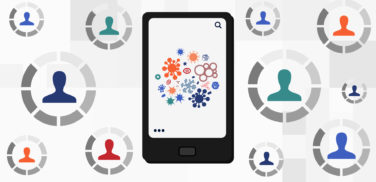Has your marketing team inadvertently created a barrier in your user experience? If so, you’re not alone. Many teams overlook an essential element of optimal user experience: Accessibility.
Imagine a customer arrives outside of a pharmacy, needing to ask an important medical question of the pharmacist. She soon discovers the pharmacy is only accessible via stairs, creating an impossible situation in her wheelchair-bound state. Discouraged, she leaves to find another pharmacy fitted with a proper ramp.
“Impossible,” you say. “It’s 2019!” But consumers regularly face such obstacles—in digital channels that are not designed with accessibility in mind. In fact, some pharmaceutical companies have unintentionally excluded a large group of people from accessing their digital content by overlooking accessibility. The results? Disappointed customers, lost profits, a tarnished reputation, and even possible legal repercussions.
Despite regulations from the Americans with Disabilities Act (ADA) and guidelines from the Web Content Accessibility Guidelines (WCAG), non-compliance persists in pharmaceutical marketing. Why? Brands are already busy trying to maintain compliance with GDPR, HIPAA, and the FDA. In some cases, accessibility gets overlooked or deprioritized.
The good news? There is a huge opportunity to get it right, outshine the competition, and create a better user experience for all.
What is Accessibility?
By its very definition, a user experience (UX) should include accessibility. After all, UX is about creating products that are easy and pleasant to use. That positive experience should extend to all users. Four areas that need consideration for modification when designing digital content are:
- Hearing
- Visual
- Motor
- Cognitive
Limitations requiring assistive measures can affect people temporarily or permanently. For example, a person may not be able to hear a video because of permanent hearing impairment from a degenerative disease, or because of temporary background noise from a crowd. Both instances are ones where an assistive, accessible approach (i.e. video captions) would improve the user experience.
Another example of accessibility in action is the use of screen reading software to navigate online without a keyboard or a mouse. But this is only possible if digital content has been properly structured and correctly labeled. Otherwise, the content will be incompatible with these assistive technologies. In effect, your digital product will be like the pharmacy mentioned earlier that had no stairs to get inside. How frustrating!
Pharma marketers have the opportunity to inform providers and consumers about products that can help improve the quality of life for patients. How can you prevent barriers to your important digital content?
Know Your Audience
Healthcare is of paramount concern to all, but most especially to the millions of consumers living with a disability. Understanding that your target audience is made up of individuals with various abilities means accessibility should be a priority, not an afterthought. Failure to keep in mind differences of ability can prevent people from even learning about your therapies, never mind using them.
Understanding the needs of your customers creates a better user experience. Creating a fully compliant digital experience that acknowledges users’ needs is good for business. It also boosts a brand’s reputation and allows marketers to effectively engage with all members of their target audience.
Legal Repercussions
Recently, in 2017, updates and clarifications were made to Section 508 of the Americans with Disabilities Act to enforce digital accessibility. Specifically, it now acknowledges WCAG 2.0/2.1, the web content accessibility guidelines created by the World Wide Web Consortium (W3C). Every single digital product in the healthcare industry must comply with rigorous accessibility standards and provide an equal experience to all users.
Failure to comply with ADA accessibility requirements can lead to major legal headaches, as some companies have recently found out via hefty lawsuits. This includes fines of up to $150,000—or even more—depending on the severity of non-compliance and loss of contracts, funding, and assistance from municipal, local, and federal government agencies.
How to Assess Accessibility
How you can ensure equal access to your online and mobile content? Some best practices to ensure accessibility include:
- Videos should have closed captions—for those with hearing impairments
- Websites should be navigable by keyboard—for those with motor impairment
- Website images should have alt tags—for those with visual impairment
- Text should enlarge easily on screens and color schemes should have appropriate contrast and sizing to ensure optimal legibility—for those with visual impairments
- Websites and videos should be listenable—for those with visual impairments or dyslexia in need of assistive technology
Wondering if your company’s digital properties are fully accessible? The only way to know is to carry out a thorough, site-wide inspection by using a combination of automated and manual testing.
Here are three tools my team finds useful in discerning accessibility compliance. These free tools serve as a valuable starting point to help you identify areas for improvement, but a thorough analysis may input from experts on what you do (or don’t) need to spend time addressing.
- Web Accessibility Evaluation Tool: A community service by WebAIM that evaluates overall page accessibility.
- Color Contrast Checker: A tool to evaluate font colors and contrast for visual accessibility, also by WebAIM.
- Accessible Colors Checker: A tool that evaluates color combination using the WCAG 2.0 guidelines for contrast accessibility.
Understanding the requirements may sound daunting but know that an accessibility assessment can help you determine the next steps to full compliance. External partners can also be valuable resources in conducting a self-audit.
Take Action
What if you discover that your digital properties are not accessible? Work with your technical team or seek out an expert partner to attain compliance. On the bright side, know that removing barriers in the user experience can instantly create new opportunities to expand the reach of your brand.
For example, prioritizing clear and accessible content will improve how Google indexes your online content. Proper headings, meta descriptions, and alt tags are all part of creating an accessible website—and allow Google to more accurately identify your content.
Even better, consider the needs of your customers and consider accessibility from the beginning in order to create the best user experience. For example, a company that markets glaucoma treatments knows that patients needing that treatment might have impaired vision; their website is likely compatible with a screen reader (which achieves baseline compliance) but actually considers the screen-reading accommodation in the design process to create a compelling experience. Engaging copy and highly descriptive alt-text for images would enhance the experience for those customers.
It’s essential that all pharma marketers consider the needs of those with different abilities in their digital content. Creating an accessible user experience can satisfy legal requirements, improve search rankings, and boost your brand’s reputation—all while creating a quality experience for every user.







